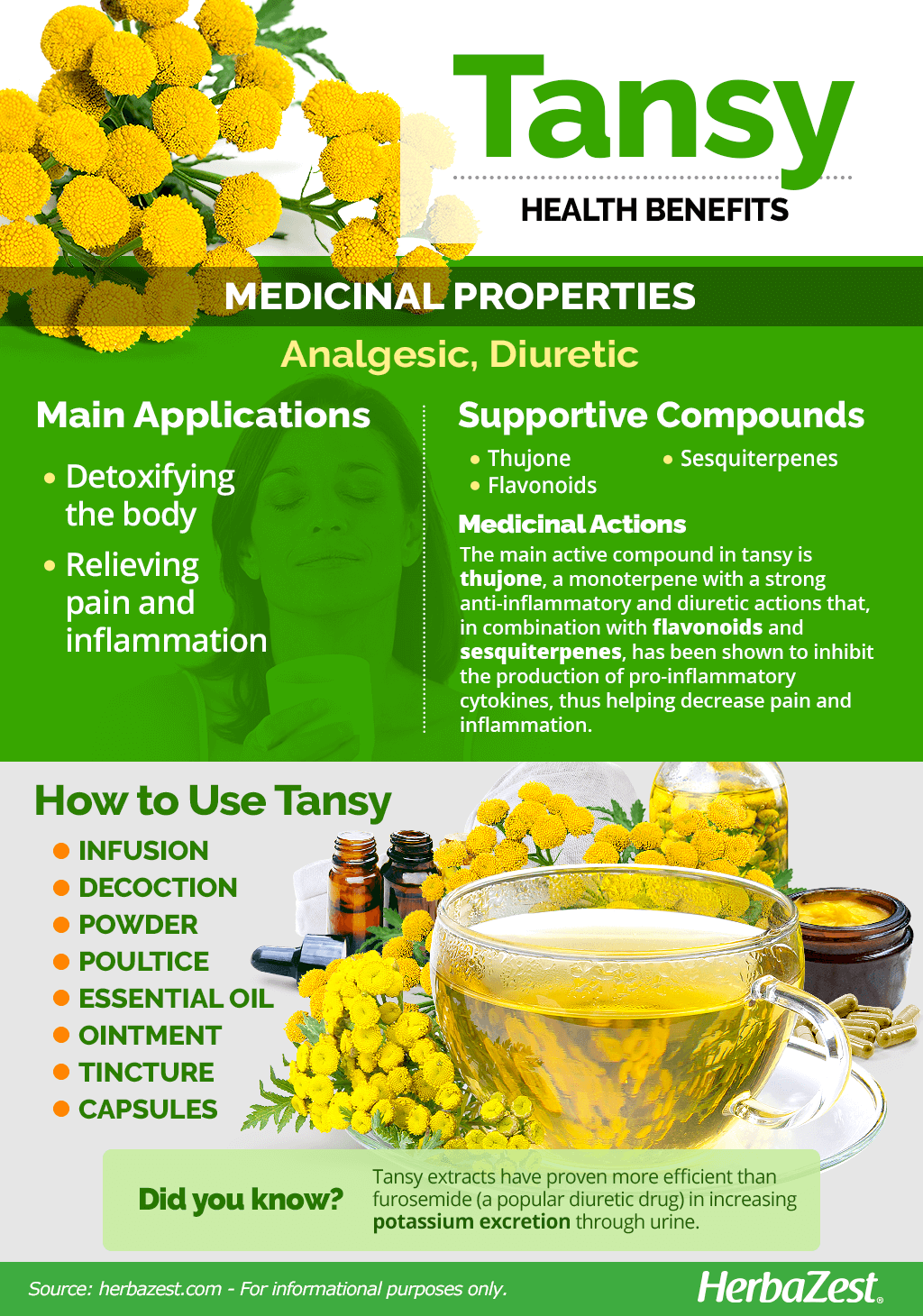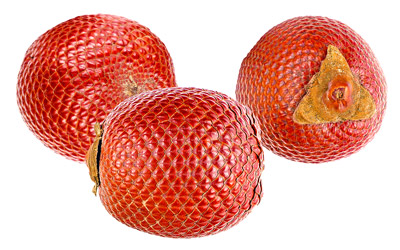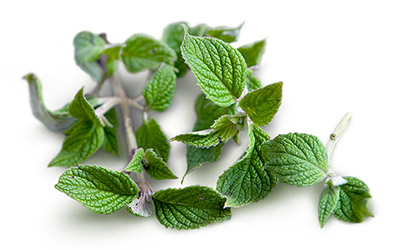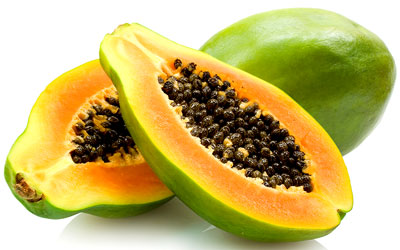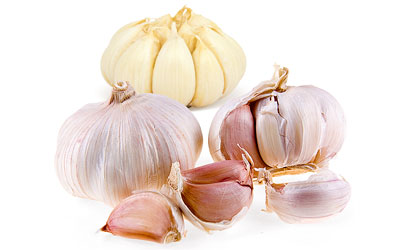Tansy - also known as common tansy, bitter-buttons, and parsley fern - has been naturalized across North America, where it is considered both an invasive weed and an ornamental plant. However, its medicinal uses can be traced back to Ancient Greece. Today, tansy remains a popular herbal remedy for many common ailments.
Tansy Medicinal Properties
Health Benefits of Tansy
Tansy boasts medicinal properties but is best known as a diuretic, analgesic, anti-inflammatory, and antimicrobial agent. Traditionally, the herb has been used to treat a wide range of conditions, including:
Detoxifying the body. The diuretic action of tansy aids in eliminating water excess and waste materials through urine, improving renal function and relieving edema as well as other conditions related to fluid retention.
Relieving pain and inflammation. Tansy has been used for centuries as an analgesic, particularly by North American tribes, to alleviate migraines and menstrual discomfort.
Additional benefits of tansy include:
Inhibiting microbial growth. Tansy has been shown to control and reduce the proliferation of harmful bacteria.
Eliminating parasites. Traditionally, tansy has been used to expel intestinal worms.
How It Works
As a medicinal plant, tansy flowers yield a volatile oil that is rich in thujone, cineole, camphor, myrtenol, and sesquiterpenes, along with flavonoids and resin. The quantities, proportions, and composition of these chemical constituents vary seasonally and from plant to plant.
Thujone is a monoterpene with strong anti-inflammatory and detoxifying properties. It has been shown to inhibit the production of pro-inflammatory cytokines, helping decrease pain and inflammation.1 Tansy's flavonoids also appear to contribute to the herb's anti-inflammatory effects.2,3
Tansy sesquiterpenes have been linked to increased serotonin production, a neurotransmitter known to inhibit pain signals in the brain, helping alleviate migraines and menstrual discomfort.2
Additionally, tansy promotes increased blood flow to the pelvic area. Its active compounds are believed to help reduce pain, stimulate bile production, and improve appetite in individuals with liver and gallbladder issues.
Although its exact mechanism of action remains unclear, tansy's traditional use as a diuretic has been confirmed by scientific studies. Research has shown it to be effective in eliminating excess fluids, as well as sodium (Na) and potassium (K).4
The herb has demonstrated antimicrobial activity in vitro against Gram-positive and Gram-negative bacteria, as well as fungi.5
Moreover, tansy oil's metabolites, produced as the oil is broken down in the liver and digestive tract, are highly toxic to internal parasites, making the herb effective for expelling worms.
Tansy extracts have been found to be more effective than furosemide, a common diuretic drug, in increasing potassium excretion.4
Detoxifying and analgesic properties similar to those of tansy are also found in herbs like angelica and sweet birch, while marigold and honeysuckle are known for their antibacterial effects.
Tansy Side Effects
Common tansy has been reported to be somewhat toxic to humans and livestock if consumed in large quantities due to the presence of thujone, a toxic compound found in its leaves. Thujone is an active ingredients in absinthe, an emerald-green liqueur popular in the 19th and early 20th centuries, which has known adverse health effects.
As a GABA receptor antagonist, thujone sensitizes neurons. In large doses, it can cause hallucinations, psychosis, and convulsions. Other side effects include stomach pain, liver and brain damage, and a rapid, weak pulse. Extreme overdoses have resulted in death.
This volatile oil can cause contact dermatitis in sensitive individuals who handle the herb or use it topically. Additionally, those allergic to plants in the Asteraceae family may also be allergic to tansy.
Tansy Cautions
Although tansy is listed on the FDA's Generally Recognized as Safe (GRAS) list, its medicinal uses are restricted due to its high toxicity.
- Women who are pregnant should never consume tansy, as it is a convulsant and can induce uterine contractions.
- Nursing women should also avoid consume tansy, as its toxic compound, thujone, can be passed to the infant through breast milk.
Since the exact concentration of toxins in tansy can only be determined through chemical analysis, it is crucial to consult a trusted healthcare practitioner before consuming tansy.
- Medicinal action Analgesic, Diuretic
- Key constituents Thujone, flavonoids, sesquiterpenes
- Ways to use Capsules, Decoctions, Hot infusions/tisanes, Tincture, Poultice, Powder, Ointment, Essential oil, Dried
- Medicinal rating (2) Minorly useful plant
- Safety ranking Use with caution

How to Consume Tansy
The use of tansy in medicines and food has declined over the years due to varying levels of the toxin thujone. However, some tansy essences free of thujone and can be used for culinary purposes. It is essential to carefully read labels on tansy products to avoid this toxic compound.
Natural Forms
Decoction. Tansy decoctions may be consumed under proper supervision to reduce fever, eliminate parasites, treat jaundice, and act as an anti-inflammatory aid.
- Infusion. The flowering heads of tansy are traditionally brewed and taken orally to expel parasites and stimulate menstrual flow.
Poultice. Crushed tansy leaves and flowers are wrapped in gauze and applied to swellings and eruptive skin diseases.
Powder. Dried and pulverized tansy leaves are used externally to treat skin issues such as bruises and blemishes.
Herbal Remedies & Supplements
- Essential oil. Tansy essential oil is recommended for external use only. It is traditionally used in aromatherapy to relieve stress and depression, as well as topically to prevent skin infections and repel insects.
Ointment. Also known as salve, this preparation is applied topically to prevent infections and soothe skin conditions.
Tincture. Tansy tincture is used to regulate menstruation, eliminate intestinal parasites, and more.
Capsules. Tansy capsules are traditionally used to ease digestive problems and water retention.
- Edible uses Flavoring
- Taste Aromatic, Bitter
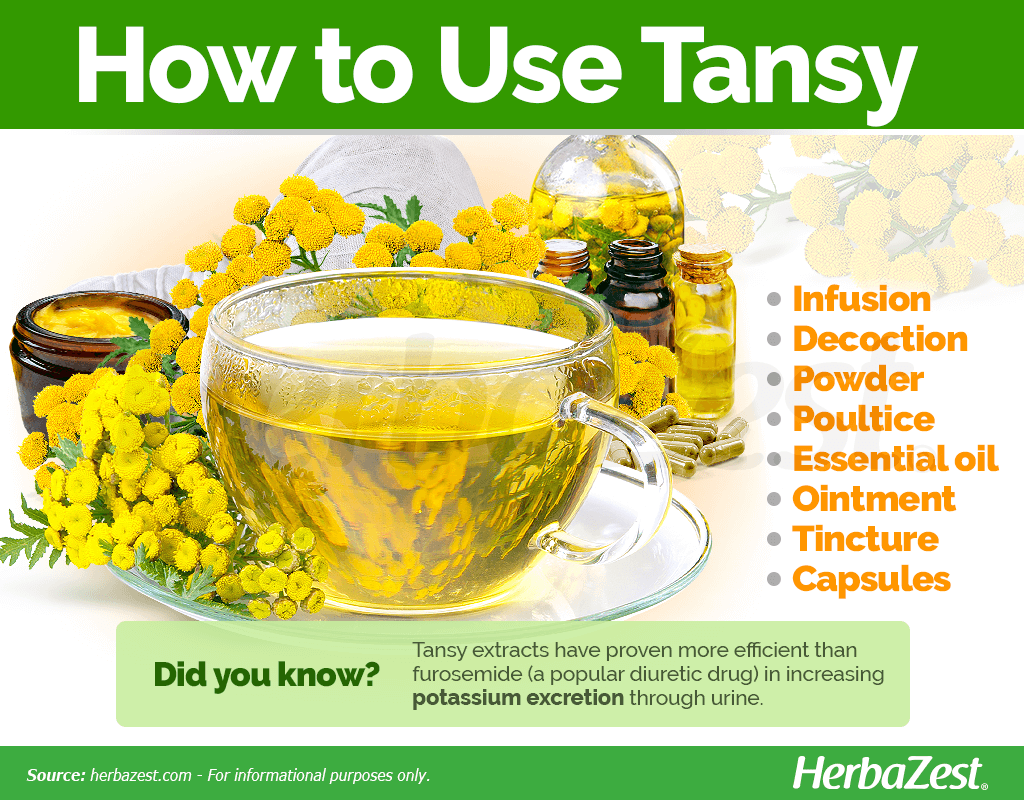
Growing
Though considered an invasive species in some areas, tansy is a beautiful flowering perennial with dark-green, fern-like leaves and yellow flowers. In the garden, tansy's foliage is often considered its most appealing characteristic, and the whole plant has a strong aroma.
Growing Guidelines
The tansy plant grows best in full sun with at least six hours of daily sunlight to thrive.
Tansy is adaptable to a wide range of soil types; however, it prefers well-drained soil with a pH of 4.8 - 7.5.
Tansy plants should be spaced 24 - 36 inches (60 - 90 cm) apart, as they are quite competitive. It is advised to grow tansy in borders with equally-invasive plants.
The edible parts are the young leaves and flowers. Young leaves should be harvested in the spring and flowers in the summer.
The tansy plant is propagated by seed or divisions. Tansy seeds can be be sown indoors in winter. After the last frost has passed, seedlings can be transplanted to permanent garden spaces.
Since tansy naturally deters pests, numerous gardeners use it as a companion plant to ward off insects such as potato, cucumber, and blister beetles.
- Life cycle Perennial
- Harvested parts Flowers, Leaves
- Light requirements Full sun, Partial shade
- Growing habitat Temperate climates
- USDA Plant Hardiness Zones 3a, 3b, 4a, 4b, 5a, 5b, 6a, 6b, 7a, 7b, 8a, 8b
- Pre-germination seed treatment Stratification
- Planting time Right after last frost
- Plant spacing average 0.6 m (1.97 ft)
- Propagation techniques Divisions
Additional Information
Plant Biology
Tansy is an aromatic perennial that grows three to four feet (90 - 120 cm) tall and wide, with erect, unbranched stems. Tansy leaves are bright green, 8 - 10 inches (20 - 25 cm) long, alternately arranged along the stems, with narrow, toothed segments. The yellow flowers grow up to 3/4 inch (2 cm) wide, forming short disc florets in tight clusters. They bloom in late summer and fall.
Classification
Common tansy, or Tanacetum vulgare, ibelongs to the Asteraceae (daisy) family, which includes over 23,000 species, ranging from small perennials to trees. Notable members include
artichoke, dandelion, lettuce, marigold, safflower, and sunflower.The genus Tanacetum consists of 152 species native to Europe and temperate regions of Asia, but T. vulgare is the most well-known for being strong aromata and medicinal properties. It is closely related to feverfew (Tanacetum parthenium), which has similar medicinal properties.
The Old English name "tansy" comes from the Greek word athanasia, meaning "immortality." The Latin variation, tanasia, was used by Linnaeus to form the plant's contemporary botanical name. The Latin term, vulgare, translates to "common," highlighting the herb's widespread presence.
Varieties and Related Species of Tansy
'Isla Gold,' the gold-leafed tansy, is shorter and is the variety most commonly offered in nurseries. However, curly tansy, or 'Crispum,' is better suited for the garden, as it is more decorative and slightly shorter. It also does not spread as quickly and has lacier leaves.
T. annuum, or blue tansy, is often confused with common tansy, T. vulgare. Blue tansy produces an essential oil that does not contain the toxin thujone but has high amounts of chamazulene, which gives the oil a dark blue color. The oil of common tansy is never blue; any blue tansy oil containing significant thujone is an adulterated product and should not be purchased.
Historical Information
Tansy has been cultivated for over 2,000 years and was first recorded in Greek botanical writings.
By the 8th century, tansy was grown in herb gardens of Charlemagne and by Benedictine monks in the Swiss monastery of Saint Gall. It was used to treat digestive issues, fevers, sores, intestinal worms, as well as to "bring out" measles.
During the Middle Ages, tansy was widely used to support women's reproductive health, from increasing fertility to preventing miscarriages.
Dried tansy was also strewn on floors and along rafters, as well as packed between bedsheets and mattresses, to deter lice, flies, and other pests.
Popular Beliefs
The Greeks believed tansy to be a divine herb. According to myth, tansy was given to Ganymede, Zeus' cupbearer, to make him immortal.
In 1755, Linnaeus documented the practice of placing tansy wreaths inside funeral shrouds to ward off worms in this Flora of Sweden.
Tansy was even part of Harvard's history – the first president of Harvard was buried wearing a tansy wreath. When his coffin was moved in 1846, the herb's distinct shape and fragrance allowed for his remains to be identified.
In North America, tansy was commonly used in funerals. Until the mid-19th century, coffins and funeral garments were often packed with tansy to repel insects.
Tansy was used so frequently in New England funerals that it became associated with death.
Other Uses
Gardening. Tansy is often used as an ornamental plant for pest control in organic gardens and sustainable agriculture.
Dye. Young tansy leaves and flower tops yield yellow and green dyes.
Perfumery. Tansy extracts are occasionally used in the fragrance industry.
Although the use of tansy has declined, the herb continues to be used to relieve migraines, support menstruation, expel parasites, and kill bacteria. If considering tansy for medicinal purposes, it is strongly advised to consult a trusted herbal practitioner for the correct dosages.
- Other uses Dye, Perfume, Repellent
Sources
- 21st Century Homestead: Biological Pest Control, pp. 143-146
- American Herbal Products Association's Botanical Safety Handbook, p. 852
- Cephalalgia, Serotonin and migraine: biology and clinical implications, 2007
- Cornell University, Tansy
- Edible Medicinal And Non-Medicinal Plants, pp. 502-512
- Flavonoids of the Sunflower Family (Asteraceae), p. 179
- North Carolina State University, Tanacetum vulgare
- PubChem, Alpha,beta-Thujone
- The Creative Herbal Home, p. 21
- University of Arkansas, Tansy
- Journal of Pharmacy and Pharmacology, Anti-inflammatory Effects of South American Tanacetum vulgare, 1998
- Journal of Ethnopharmacology, Diuretic activity of the aqueous extracts of Carum carvi and Tanacetum vulgare in normal rats, 2007
Footnotes:
- Proceedings of the National Academy of Sciences of the United States of America (PNAS). (2000). α-Thujone (the active component of absinthe): γ-Aminobutyric acid type A receptor modulation and metabolic detoxification. Retrieved February 24, 2025, from: https://pubmed.ncbi.nlm.nih.gov/10725394/
- Plants (Basel). (2023). Chemical Profiling and Antioxidant Activity of Tanacetum vulgare L. Wild-Growing in Latvia. Retrieved February 24, 2025, from: https://pmc.ncbi.nlm.nih.gov/articles/PMC10221018/
- Medicines (Basel). (2017). Anti-Inflammatory, Antioxidant, Antibiotic, and Cytotoxic Activities of Tanacetum vulgare L. Essential Oil and Its Constituents. Retrieved February 24, 2025, from: https://pubmed.ncbi.nlm.nih.gov/28930249/
- Journal of Ethnopharmacology. (2007). Diuretic activity of the aqueous extracts of Carum carvi and Tanacetum vulgare in normal rats. Retrieved February 24, 2025, from: https://pubmed.ncbi.nlm.nih.gov/17113735/
- Medical Science Monitor Basic Research. (2019). Antifungal and Synergistic Effects of the Ethyl Acetate Extract of Tanacetum vulgare (L.) Against Candida albicans. Retrieved February 24, 2025, from: https://pmc.ncbi.nlm.nih.gov/articles/PMC6730044/
